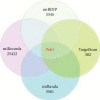miR-21 and Pellino-1 Expression Profiling in Autoimmune Premature Ovarian Insufficiency
- PMID: 32352018
- PMCID: PMC7174929
- DOI: 10.1155/2020/3582648
miR-21 and Pellino-1 Expression Profiling in Autoimmune Premature Ovarian Insufficiency
Abstract
Background: Premature ovarian insufficiency (POI) represents the hypergonadotropic hypoestrogenic symptoms that result in the loss of ovarian follicles. 5-30% POI cases are suggested to be involved in autoimmune etiology. MicroRNA-21 (miR-21) plays a vital role in ovarian folliculogenesis via regulating and interacting with multiple target genes. Here, we conduct the target prediction of miR-21, identify the expression and correlation of miR-21 and its putative target Pellino-1 (Peli1), and confirm their relationship with clinical characteristics in autoimmune POI.
Methods: Bioinformatic analysis was conducted to screen the miR-21 putative target gene. Autoimmune POI mouse models were established by ZP3 immunization. Serum miR-21, Peli1 mRNA of peripheral blood mononuclear cells (PBMCs) and regulatory T cells (Tregs), general status, spleen Tregs ratio, inflammatory factors, ovarian endocrine function, and ovarian structure were evaluated. For autoimmune POI patients, serum miR-21, PBMCs Peli1 mRNA levels, general data, immune parameters, hormone levels, and ultrasound examinations were obtained. The correlations of miR-21 with Peli1 and clinical characteristics in patients were analyzed.
Results: Peli1 was selected based on four microRNA prediction databases and literature retrieval. In mouse models, serum miR-21 level, PBMCs and Tregs Peli1 mRNA, and spleen Tregs ratio were 0.61 ± 0.09, 0.12 ± 0.12, 0.27±0.23 and 4.82 ± 0.58, respectively, lower than those in the control group. In patients, miR-21 level (0.60 ± 0.14) and Peli1 mRNA (0.30 ± 0.14) were lower than those in the control group (1.01 ± 0.07 and 1.63 ± 0.54); miR-21 was positively related with Peli1, AMH, E2, the size of the uterus, and ovarian volume and negatively related with FSH, LH, and the number of positive immune parameters (AOAb, EMAb, ACL, ANA, ds-DNA, ACA, IgG, IgA, IgM, IgE, C3, and C4).
Conclusions: Low expressions of miR-21 and Peli1 were detected in autoimmune POI mice and patients. Positive correlation between miR-21 and Peli1 was observed in autoimmune POI patients, suggesting that miR-21 and Peli1 might be associated with the pathogenesis of autoimmune POI.
Copyright © 2020 Xinran Li et al.
Conflict of interest statement
The authors declare that they have no conflicts of interest.
Figures




Similar articles
-
Regulatory T Cells Overexpressing Peli1 Show Better Efficacy in Repairing Ovarian Endocrine Function in Autoimmune Premature Ovarian Insufficiency.Lab Invest. 2023 Feb;103(2):100005. doi: 10.1016/j.labinv.2022.100005. Epub 2023 Jan 10. Lab Invest. 2023. PMID: 37039145
-
Hydroxychloroquine protects against autoimmune premature ovarian insufficiency by modulating the Treg/Th17 cell ratio in BALB/c mice.Am J Reprod Immunol. 2023 Apr;89(4):e13686. doi: 10.1111/aji.13686. Epub 2023 Feb 19. Am J Reprod Immunol. 2023. PMID: 36752682
-
Bu-Shen-Ning-Xin decoction ameliorates premature ovarian insufficiency by suppressing oxidative stress through rno_circRNA_012284/rno_miR-760-3p/HBEGF pathway.Phytomedicine. 2024 Oct;133:155920. doi: 10.1016/j.phymed.2024.155920. Epub 2024 Jul 29. Phytomedicine. 2024. PMID: 39126922
-
Role of microRNAs in premature ovarian insufficiency.Reprod Biol Endocrinol. 2017 May 12;15(1):38. doi: 10.1186/s12958-017-0256-3. Reprod Biol Endocrinol. 2017. PMID: 28499456 Free PMC article. Review.
-
Prediction of premature ovarian insufficiency: foolish fallacy or feasible foresight?Climacteric. 2021 Oct;24(5):438-443. doi: 10.1080/13697137.2020.1868426. Epub 2021 Jan 31. Climacteric. 2021. PMID: 33522318 Review.
Cited by
-
Biology of Pellino1: a potential therapeutic target for inflammation in diseases and cancers.Front Immunol. 2023 Dec 18;14:1292022. doi: 10.3389/fimmu.2023.1292022. eCollection 2023. Front Immunol. 2023. PMID: 38179042 Free PMC article. Review.
-
The Role of Noncoding RNA in the Pathophysiology and Treatment of Premature Ovarian Insufficiency.Int J Mol Sci. 2021 Aug 28;22(17):9336. doi: 10.3390/ijms22179336. Int J Mol Sci. 2021. PMID: 34502244 Free PMC article. Review.
-
Comprehensive analysis of mRNA and miRNA differential expression profiles in the hypothalamus-pituitary-gonadal axis in laying and broodiness period of Wanxi white geese.Poult Sci. 2025 Jan;104(1):104510. doi: 10.1016/j.psj.2024.104510. Epub 2024 Nov 9. Poult Sci. 2025. PMID: 39549391 Free PMC article.
-
Potential MiRNA therapies for premature ovarian failure: new challenges and opportunities.Stem Cell Res Ther. 2025 Jul 15;16(1):364. doi: 10.1186/s13287-025-04514-z. Stem Cell Res Ther. 2025. PMID: 40660302 Free PMC article. Review.
-
Epigenetic regulation in premature ovarian failure: A literature review.Front Physiol. 2023 Jan 4;13:998424. doi: 10.3389/fphys.2022.998424. eCollection 2022. Front Physiol. 2023. PMID: 36685174 Free PMC article. Review.
References
-
- Overbeek A., van den Berg M. H., van Leeuwen F. E., Kaspers G. J., Lambalk C. B., van Dulmen-den Broeder E. Chemotherapy-related late adverse effects on ovarian function in female survivors of childhood and young adult cancer: a systematic review. Cancer Treatment Reviews. 2017;53:10–24. doi: 10.1016/j.ctrv.2016.11.006. - DOI - PubMed
MeSH terms
Substances
LinkOut - more resources
Full Text Sources
Medical
Miscellaneous

